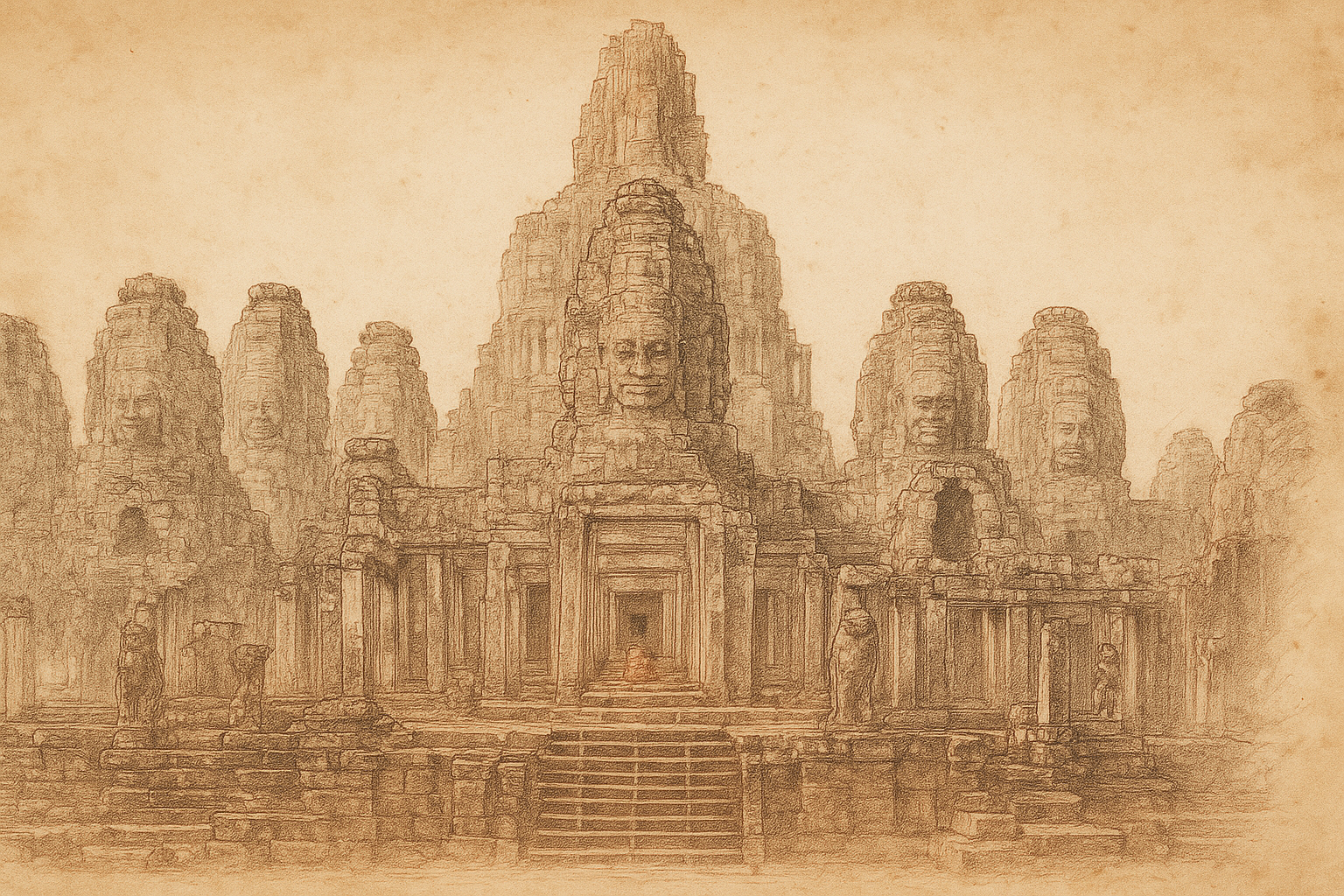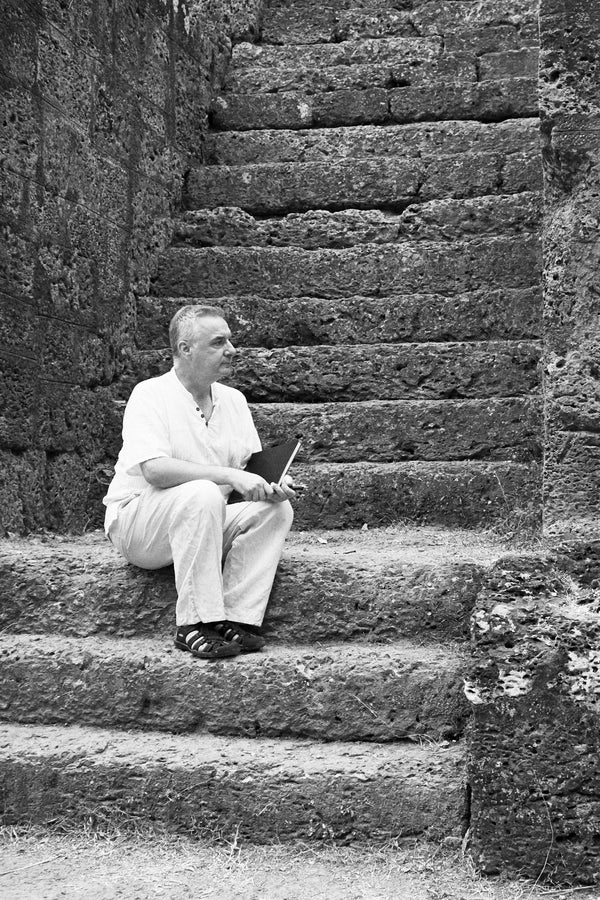Complimentary worldwide shipping on orders over $400 · No import tariffs for most countries
Complimentary worldwide shipping on orders over $400 · No import tariffs for most countries

In the Shadow of the Sacred Wall - Morning at the Bayon
4 min read
Bayon Temple · Southern Inner Gallery — July 2025
In the mist-warmed stone / gods exhale through broken walls / the world begins here.
We entered before light had yet found its way between the towers.
Bayon is never truly silent—not even when the gates are empty, not even at dawn. There is a presence here that listens through the hush, that breathes through the stone and leans gently into the pale veils of evaporating rain. The monsoon had passed in the night, and the sandstone beneath our feet was warm, perfumed with moss and the strange sweetness of time. A low mist hovered above the flagstones, drifting as if remembering how to rise. This was not Earth. Or, perhaps, this was Earth remembered—before forgetting.
Annie walked beside me across the eastern terrace. We passed beneath the gaze of towers, the faces watching with their unfathomable stillness. The western clouds had not yet broken, but behind the jungle canopy, light began to stir. It fell in soft drapery through the eastern galleries. We paused near the southwestern corner, where a lone seated Buddha rests against the darkened wall, and there we knelt. We lit incense and whispered the names of those we love. The breath of prayer curled upward and lingered in the hush.
It was only as we turned again toward the southern inner gallery that I felt the pull of something older than memory. Not the grand gestures of the outer walls—not the elephants, the armies, the thunder of drums—but something quieter, carved more inwardly. These bas-reliefs lie cloaked in shadow even by day. The ceiling here still holds. The light seldom enters. Time has moved slower. In places, water has seeped through, blackening the walls, partially erasing the carvings. But the sacred is not diminished. If anything, the darkness makes it more real.
I had come to visit an old friend. Not a person, but a procession—a sacred wall I have returned to many times, where Vishnu and Shiva still receive the prayers of kings.
The walk felt like a rite of passage: past Garuda lifting a mountain, past lions and kings in struggle, past the illness of a prince and the healing wrought by devotion. Pradyumna’s tale unfolded too—the river, the fish, the hands that pulled him back from death. But I walked on.
Toward the western end of the southern wall, the carvings begin to change. The battles fall away. The air quiets. The stone begins to listen.
And there she was again—serene, still—a lady in a lotus boat.

A lady in a lotus boat gathers silence among the reeds.
The water is only suggested, a gentle curve beneath the hull. The lotus blossoms are half-carved, the trees unfinished. But her gaze is eternal. She is not merely gathering—she is returning. In her gesture, I see the soul of the temple itself: drifting, delicate, profoundly present.
Nearby, a royal audience. A friend collapses below the king’s high seat.

A friend falls faint, and is held by unseen hands.
There is pathos here, unexpected. The divine is not distant. It dwells in the smallest gesture: a hand reaching, a courtier leaning close, the lion above them watching all.

A prince points the way as a guardian lion keeps watch.
He gestures left, toward the sacred arch where the procession begins. I have drawn this many times, and always I feel the same hush—like the moment before the gods appear.
Then the next panel drew me deeper.

The king bows low before Vishnu’s silent form.
The king’s body bends in reverence. Vishnu stands unmoved. The power here is absolute stillness. Behind them, the carved canopy trembles with age, yet the moment remains untouched. This is devotion rendered in stone.
I lingered long at the next carving.

A hermit flees a tiger as rabbits scatter in a forest glade.
There is fear, yes—but more than that, harmony. A balance between wildness and wisdom. I return often to sketch the rabbits—not because they are central, but because they are present. This is a forest where everything is seen.
And then, once more, the water.

Shiva stands in a sacred lake, waving to kneeling kings.
He is smiling.
How does stone smile?
Because it remembers.
Because it has been seen.
In Angkor times, they say, the gods were not symbols. They were vessels. This Shiva, surrounded by fish and royalty, still waves. His gesture is not metaphor. It is welcome.
Stone carved in mistlight
my chalk barely finds the line—
but still, I see you.
Just before I left the gallery, one final scene pulled me in. It stood apart, both in tone and in rhythm. At its center, Shiva sits at the temple gate, his posture oddly human. His face is neither serene nor fierce—but alert, almost amused. On each side of the terrace, naga balustrades curl outward toward the moat. And just below, two princesses pass by in parade boats—dignified, distant, dreamlike.

Shiva watches from the gate as royal boats glide below.
I drew the scene in silence, letting the balustrades guide my hand downward, tracing their arc into the water and the boats beyond. By the time I finished, the first voices of other visitors echoed faintly behind me.
My fingers were red with dust when Annie returned. I had not moved far. Only a few meters, perhaps. But I had gone deep.
We walked out the way we came. Past Vishnu. Past the tiger. Past the lotus boat. The mist had lifted. The light was gold.
I thought of the ones I pray for. I thought of the silence I had just left.
And something ancient stirred in the breath between those two thoughts—
A stillness that shelters everything.
The Gaze Beyond Time
Photographs from Bayon Temple – Spirit of Angkor series by Lucas Varro
At the quiet heart of Angkor Thom stands Bayon—a temple not of distance, but of presence. Here, within a sanctuary of face towers and shadowed corridors, stone watches stone, and silence looks back with a gaze as serene as it is infinite.
These monumental visages—half-smiling, half-sleeping—rise above the treetops like contemplative sentinels, their features weathered by rain, light, and centuries of unseen prayer. At Bayon, the sacred is not hidden; it is met in every direction, every turning, every pause. This is a temple of interior vastness—less a monument than a mirror to the soul.
In this collection from the Spirit of Angkor series, Lucas Varro draws near to these enigmatic faces and the subtle mysteries they hold. Using large and medium format black-and-white film, each image is shaped through long exposure and chiaroscuro, then hand-toned by the artist to reveal not only the architecture—but the atmosphere within it. Stillness shaped by shadow. Compassion carved in light.
Offered as limited edition prints on museum-grade Hahnemühle Bamboo paper, each photograph is accompanied by a Collector’s Print Package containing poetic writings, curatorial notes, and reflections drawn from the artist’s field journals.
This is Bayon not as history—but as presence. A sanctuary of stone that sees you, even now.
Join My Studio Journal
Receive occasional letters from my studio in Siem Reap—offering a glimpse into my creative process, early access to new fine art prints, field notes from the temples of Angkor, exhibition announcements, and reflections on beauty, impermanence, and the spirit of place.
No noise. No clutter. Just quiet inspiration, delivered gently.
Subscribe and stay connected to the unfolding story.

Join My Studio Journal
Receive occasional letters from my studio in Siem Reap—offering a glimpse into my creative process, early access to new fine art prints, field notes from the temples of Angkor, exhibition announcements, and reflections on beauty, impermanence, and the spirit of place.
No noise. No clutter. Just quiet inspiration, delivered gently.
Subscribe and stay connected to the unfolding story.




